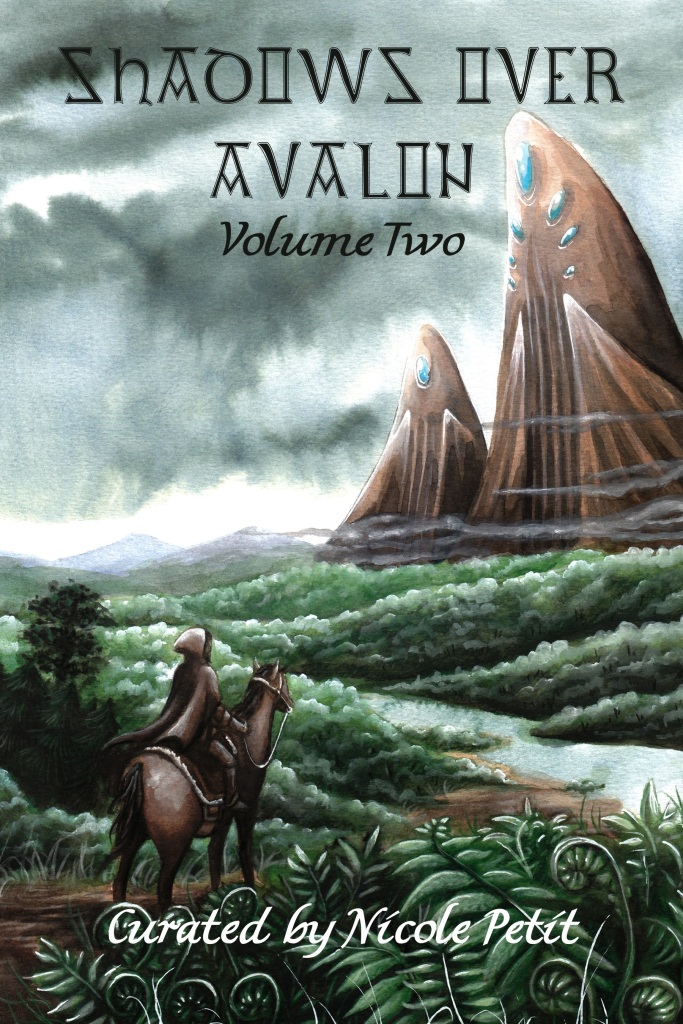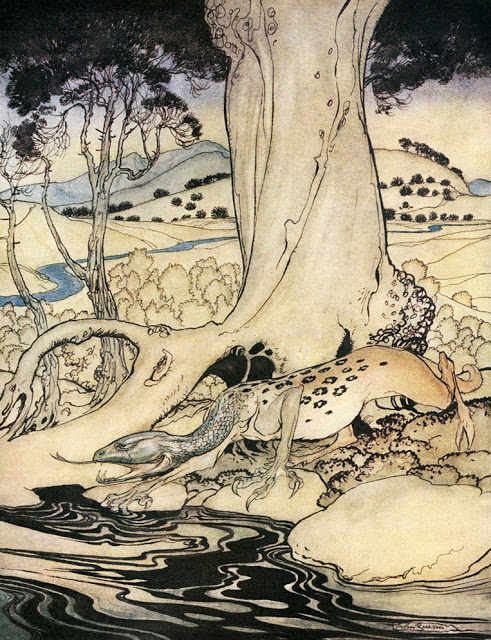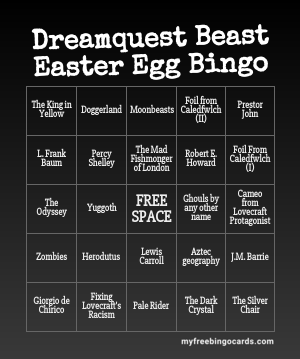(For fans and friends voting in the Critters Readers Poll, you can scroll down to instructions at the bottom of the post)
Discover the story behind the strange obsession of Camelot’s strangest knight.

You know you want it.
As an author, the two things I hang my proverbial hat on are Arthurian mythology (via my Bel Nemeton series) and Mythos-infused historical fiction. So, when 18th Wall Productions put out a call for “Camelot vs. Cthulhu” stories for an upcoming anthology, I knew I had to be involved.
As it turns out, 18th Wall got so many quality submissions that the resulting anthology, Shadows Over Avalon, encompasses two volumes, both edited by the ever superb Nicole Petit. Volume I focus on tales of traditional Lovecraftian cosmic horror, and it’s filled with names who do not disappoint, such as Simon Bucher-Jones, Edward Erdelac, and Josh Reynolds. Volume II channels Lovecraft’s other side, stories of shifting perceptions and realities, fantastical journeys, and dreams. There, you will find my novella “The Dreamquest Beast” along with stories by worthy authors such as Georgia Cook, Kara Dennison, Lukasz Furmaniak, Sophie Iles, and C.L. Werner.
“The Dreamquest Beast” is a non-canonical story set in my Bel Nemeton universe (leading my beloved wife to observe “So, you’re writing your own fanfic now?”).
Taking place a generation before the start of Bel Nemeton, when Arthur is an infant and Merlin still known as “The Wanderer,” northern Britain bakes under an unending drought unlike any in memory. As brave warriors and shield maidens take up the quest to discover what afflicts the land and set matters to right, the would-be champions invariably fail and fall. After the quest claims his much loved older brother, Prince Pelinyr (or “Pellinore” in more contemporary renderings) of Damnonia becomes the unlucky 13th to take up the challenge.
“So, you’re writing your own fanfic now?”
My wife (who, and I say this not only because it’s true but also because she may be reading this, is my biggest fan)
On the surface an unlikely hero, Pelinyr has all his life been plagued by nightmares and strange occurrences surrounding his dreams. In this desperate endeavor, he is joined by his friends: the gregarious Prince Cynfarch of Gorre, the clever Prince Tuadel of Alclud, and Jana, Pelinyr’s childhood playmate, now a shunned sorcerer and seer haunting a cursed Roman amphitheater. Together, the four will cross the wild frontier into the kingdoms of the dreaded Saxons before descending through a black tower without name or builder into the land of dreams themselves.
Once in the Dreamlands, the challenges and dangers only grow. The company will meet gods, battle monsters, take caravans into deadly jungles and endless deserts, pour over tablets written in unearthly tongues, and solve riddles that are a matter of life of death for the companions and for millions back in the waking world.

Pelinyr has always been one of my favorite members of the Round Table as well as, to me, one of the most fascinating. Along with Galahad and Percival, he is one of the knights that is “touched” in a way Arthuriana usually reserves for its Druids/Magicians/Whatever you want to call them. For Galahad and Percival, that mania is clearly religious in nature. With Pelinyr, however, its source is never clearly defined. Certainly, it seems to be connected with the “Questing Beast,” the strange creature which he is sworn to follow but which only he can see – but whether the beast is a cause or effect of Pelinyr’s madness is unknown.
This characterization of Pelinyr is surprisingly consistent throughout Arthuriana: from Malory’s Le Morte d’Arthur, where it is implied he is afflicted by his relation to the Fisher King, to the eccentric and slightly senile figure of T.E. White’s Once and Future King.
This aspect of Pelinyr has been incorporated into my Bel Nemeton series. Pelinyr is a minor yet significant figure in the second book, Caledfwlch. The book opens with a friendly duel between Arthur and Pelinyr, as Merlin looks on and frets about Pelinyr’s instability manifesting during the combat. And Caledflwch ends with, in a fit of inspiration, Pelinyr being the one who finds the true name of Arthur’s new blade and becoming the first significant British noble to pledge fealty to Arthur.
So, the idea of “Dreamquest Beast” (a kind of titular portmanteau of Arthuriana’s “Questing Beast” and Lovecraft’s “Dream Quest of Unknown Kadath”) as a thought-experiment exploring how Bel Nemeton’s Pelinyr “got that way” and the origins of the Questing Beast was extremely appealing. Like many previous authors, scholars, and artists, I connect the Questing Beast with the mythical creature known as the camelopardus or camelopardalis. Additionally, I thought it would fun to take two of the foils from Caledfwlch (both based on historical 6th century British rulers), make them Pelinyr’s boon companions in “Dreamquest,” and explore the roots of their own transitions from friend to foil.
The Riddle of the Questing Beast, from “Dreamquest Beast”I am Cameleopardus
From the Serpent, Master of Cunning, comes my Head.
From the Leopard, Lord of Fleetness, is taken my Body
From the Lion, King of Bravery, are drawn my Haunches
From the Hart, Emperor of Virtue, are given my Feet.
And from Sacrifice, I take Breath and Mind and Life
As a writer, I’ve dropped elements of Lovecraft and the Mythos into my stories dozens of times. Doing it with “Dreamquest,” perhaps because I was cutting from the whole cloth of the Dreamlands rather than picking and choosing an element or two for what was essentially my own world, was different. I felt a tremendous sense of pressure, even obligation, to be “good enough” and “get it right.” For all that, it was enormously exciting, one of the most exciting things I’ve done as an author, both to be able to use my favorite elements of the Dreamlands and to add more than a few things of my own.
I also peppered “Dreamquest Beast” with Easter eggs, weaving in nods and shout-outs to stories, myths, and legends from Herodotus to Jim Henson, which also play with the dreamlike, the surreal, or the radically fantastic. Likewise, I endeavored to keep things fresh by occasionally using established Mythos creatures without naming them or renaming them in accordance with cultures involved in the stories (such as using the Saxon “barrow wights” for Lovecraft’s ghouls).

As part of giving “Dreamquest Beast” a distinctive and appropriate atmosphere, I also played with the language of the story. For those of you familiar with my other work, no part of “Dreamquest” is quite in my usual authorial voice. In the first and third acts, taking place in the waking world of 6th century Britain, I have leaned hard into the conventions of epic poetry. For the second act, occuring in the Dreamlands, I have attempted to channel the distinctive language Lovecraft used in the Dream Cycle.
I am very gratified that “Dreamquest,” despite only being released in December, has already been nominated for “Best Science Fiction or Fantasy Short Story of 2022” in the Critters Readers Poll. For fans and friends interesting in supporting me, I’ve included directions for voting below:
- Go here.
- Scroll down until you find “The Dreamquest Beast / Jon Black / 18th Wall Productions and then tick the circle
- Scroll down again and enter your name and email address in the appropriate fields
- Jump through their “I’m not a bot” hoop by looking at the random book cover they show you and entering the name of its author in the appropriate field
- Click “Submit Vote”
- You’ll get a confirmation email sent to you, click the link in the email to confirm your vote.
“The Dreamquest Beast,” part of Shadows Over Avalon: Volume II from 18thWall Productions, is available in paperback and ebook formats.